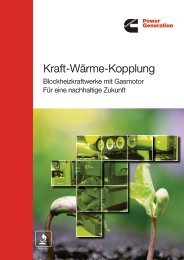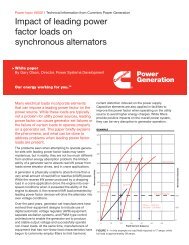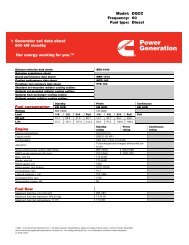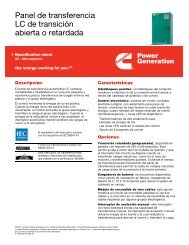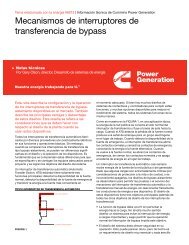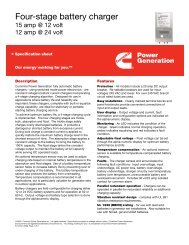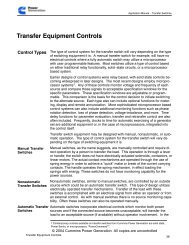appendix
appendix
appendix
You also want an ePaper? Increase the reach of your titles
YUMPU automatically turns print PDFs into web optimized ePapers that Google loves.
Detailed Load<br />
Calculations<br />
APPENDIX A<br />
Rev. Jan 2011<br />
Application Manual – Liquid Cooled Generator Sets<br />
• Effective Surge kW – the Cumulative Peak kW times a multiplier to account for the<br />
reduced load effect due to sustained reduced output voltage during the transient<br />
surge load.<br />
• Effective Surge kVA – the Cumulative Peak kVA times a multiplier to account for the<br />
reduced load effect due to sustained reduced output voltage during the transient<br />
surge load.<br />
The following documents all of the individual load requirements calculations. Load<br />
running, starting and peak surge requirements are calculated for each load based on<br />
assumed default operating characteristics as displayed on the individual load entry forms.<br />
Light Load Calculations<br />
Three different light load types can be entered:<br />
Fluorescent – A low–pressure mercury type discharge lamp where most of the light is<br />
emitted by an excited layer of fluorescent material. The same load characteristics are<br />
used for ballast or electronic types. Both are non–linear loads, but GenSize ignores the<br />
non–linearity for this load type since this is usually a small part of the total connected<br />
load.<br />
Incandescent – Standard bulb type lamp assemblies, which use a filament to create light.<br />
Discharge (HID) – Lamps that produce light by passing a current through a metal vapor;<br />
includes high pressure sodium, metal halide, and mercury vapor discharge lighting.<br />
RkW If kVA entered: RkW = kVA x RPF<br />
If Ramps entered: 1∅ RkW = (Ramps x voltage x RPF) ÷ 1000<br />
3∅ RkW = (Ramps x voltage x RPF x 1.73) ÷ 1000<br />
RkVA If RkW entered: RkVA = RkW ÷ RPF<br />
If Ramps entered: 1∅ RkVA = (Ramps x voltage) ÷ 1000<br />
3∅ RkVA = (Ramps x voltage x 1.73) ÷ 1000<br />
RPF Running power factor as entered or default<br />
SkW SkW = RkW for incandescence and florescence<br />
SkW = 0.75 x RkW for HID<br />
SkVA SkVA = SkW ÷ SPF<br />
SPF SPF = RPF, except for HID where default SPF = 0.85<br />
AkW AkW = RkW<br />
Ramps 1∅ Ramps = (RkW x 1000) ÷ (voltage x RPF)<br />
3∅ Ramps = (RkW x 1000) ÷ (voltage x RPF x 1.73)<br />
Air Conditioner Load Calculations<br />
GenSize simply converts tons to horsepower for sizing air conditioning loads at 2 HP/ton<br />
as a conservative estimate of the total load for a lower efficiency unit. If you want a more<br />
exact size and know the individual component motor loads in the A/C equipment, enter<br />
them individually and come up with a demand factor for what loads are likely to start<br />
simultaneously.<br />
RkW RkW = AC Tons x 2 x 0.746<br />
RkVA RkVA = RkW ÷ RPF<br />
RPF Running power factor as entered or default from database<br />
SkW High Inertia SkW = SkVA x SPF<br />
Low Inertia SkW = SkVA x SPF x 0.6<br />
SkVA SkVA = HP x (LRkVA/HP) x SkVA factor, where<br />
LRkVA/HP is the average kVA/HP for the NEMA Code letter of the motor,<br />
and SkVA factor is 1.0 for full voltage starting, or from reduced voltage<br />
starting table (see Reduced Voltage Starting Method)<br />
SPF As entered, or default values from database by HP and starting method<br />
For loads that are designated to automatically cycle on and off:<br />
A–9



